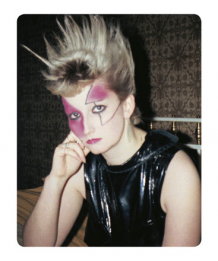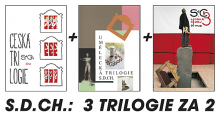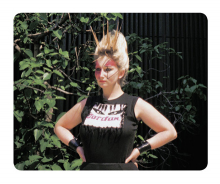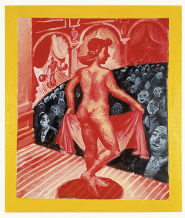| Zeitschrift Umělec 2004/4 >> Jiří Skála: A Simple Turn of a Screw | Übersicht aller Ausgaben | ||||||||||||
|
|||||||||||||
Jiří Skála: A Simple Turn of a ScrewZeitschrift Umělec 2004/401.04.2004 Emilie Renardová | profil | en cs |
|||||||||||||
|
Jiří Skála was born in 1976, and lives and works in Prague. The elaborated systems that Skála employs in his works are reminiscent of the results of a self-taught scientist. He attempts to verify principles, build theories, investigate and gain control of enclosed groups of objects in all surrounding fields, so that he—with the help of his somewhat indefinite scientific knowledge based on his own observation and proved by repetition and imitation—constantly renews the field of his investigations. It is as if the primary postulate of Skála was that his theory neither doubts nor confirms any experience, but is the complete cohesion of logical systems in which the value of truth is substituted by a value of validity.
In every work he creates a specific global logical system that, together with others, gives birth to a rich collection of worlds with variable arrangement. Skála confines the explorative space for his experiments and inserts rules for observation that he applies strictly and regularly. He measures, controls, verifies and filters all information with his reckoning. He methodically inserts miniature and quasi-theoretical deviations into existing systems. Faults and dysfunctions such as dust, minute deviations in distance or the turn of a screw are destructive to the order of things—even in the small scale. Skála’s working method is as important as the outcome. Sometimes even though a work’s creation required a lot of time, the result isn’t even visible. In such cases, we can only take Skála at his word. His careful interventions are often part of the works whose physical existence is not visible—a video of an action, photographic documentation presented as a proof, lists, time sheets, inconspicuous fakes, slight shifts of objects or people. Artistic and scientific activity, that relies on the fact that we first set rules and then invariably and determinedly follow them taking note of neither time nor result, can sometimes be understood as manic insanity. This attitude is the engine behind the work of Skála, who is constantly setting new rules, categories, laws, registers, and units of measure in order to span the world with his own order, a personal cosmos that is in its own way as unique as that of a crazy individual. To delineate, classify and “dig over” means imposing a manner of perceiving existing things. This means changing the meaning of everything by adjusting the configuration. A chronological or exhaustive way of describing the work of Skála would be the most reliable method, but I tend to overlook such routes. His instruments of measurement—in the same wanton and maniacal manner as Skála, I set them to a compact collection of his works possibly missing many of their aspects: I use the method of Jiří Skála. In the category To delimit the space of investigation, the way of perception and the object of observation within given time we are witnesses of the first focusing attempt to introduce Skála’s technique. In the video Bus-O (2000) Jiří Skála films a small metal object on the floor of a bus while it goes through a city. As the camera’s gaze never departs from the fixed point, so the tape loop engenders a hypnotic experience. As the object turns around on its axis in synch with the irregular jolts of the bus, it seems to develop a movement of its own invoked by the hypnotic power of concentration. Skála’s camera never gazes at the surrounding city, paying instead nearly obsessive attention to this common object. The ability to focus on a limited and precisely measured space is illustrative of the artist’s method; he consciously pursues such objects of scrutiny past the frontiers of absurdity and stupor. Let the world turn round, Jiří Skála seeks no truth in it... Another tentative manifestation of all possibilities, is under the genre : “Compilation and classification of a completed ensemble of objects” into which a small series of Skála’s works is able to enter. The desire to know have an encyclopedic knowledge of a precise field is appeased by the Internet, that “infinite source of information,” according to the access provider’s publicity material. But what becomes of that desire when it exceeds the limits of information? Is there an afterlife? (2001) is a compilation of all the responses obtained to this question using the Alta Vista search engine, published in a 200 page volume. This naďve question of obsolete romanticism was asked by Skála on a computer, and pushed to the end his willingness to know and accept the sum of his responses without exception. He followed a tautological plan postulating that in the absence of a good response, none of the answers contradict any of the others, and therefore any answer is hypothetically valid. Thus, this absence resolved on choice leaves all possibilities open and the responses received to this question of existential order are of all sorts, including religious theories, cartoons, recipes, and anti-virus programs. Skála’s book ultimately addresses many aspects of life that go way beyond questions of life after death. Another response applicable to this query: Refining Household Waste (2001) is a product of a systematic and rigorous process applied to a finished universe: sixteen vacuum cleaner bags. Each bag is dissected, its spread out contents, sorted by kind so that the remainder can be stuffed into a single bag. Skála described this one day action this way: “Marek Ther and I collected 16 vacuum cleaner bags filled with common domestic garbage. The sacks were of various sizes, shapes, designs and origins. The first day, we cut them open and spread their contents out in straight lines on the floor and arranged them into piles of similar qualities. After the sixteenth, a nest emerged that looked like Mendel’s chart for crossing colored peas. In the same way, we selected their contents, took half of it and Hoovered that into eight bags. Then, we made eight bags into four and four bags into two until only one bag remained. The next day, we pasted pictures of the process and information in the gallery describing the inside of each bag, with diagrams.” In observing the transmission of the morphological characteristics of green peas over the course of several generations, the Moravian Gregor Mendel defined the fundamental laws of modern genetics. Jiří Skála and Marek Ther proceed as Mendel had before them, by observing the heredity if traits of different vacuum cleaner bags: By recombining and compiling, sorting and vacuuming until reaching the irreducible matter with its incidental qualities removed, and of its dust. The esthetic quality of Jiří Skála and Marek Ther’s research that can be seen in the arrangement of the bags into different sizes and of cyclical work of classification of dust, counts as much as Mendel‘s beautiful simplicity of the history of peas. Jiří Skála and Marek Ther, pragmatic artists more than culinary scientists, undertook the experiment to reorganize the dust of different origins into a single, sorted, select nest arranged as with a desire to have control over the chaos of the most macroscopic of our familiar world. This will to organize macroscopic forgotten matter of our familiar world can be associated with another of Skála’s working categories: “Measure and accountability” that could perhaps rely on this one : “Where it is a question of Death” when it concerns a count of bodies. Four white cubes of various dimensions are set on the ground. This involves a precise measurement of the volume of the bodies of members of the Skála family: The father, the mother, the sister and Jiří himself. Measuring of volume (2002) was carried out according to a simple process of measurement inherited from Archimedes: He submerged members of his family into a water tub, and then measured the change in level. From that, he was able to calculate the volume in liters corresponding to each one of his family’s bodies. Jiří Skála then translated these bodies into cardboard cubes according to their exact volume, and assembled them into what he thought would be the most appropriate form for packing merchandise. It would appear that these cubical white forms when set out in space in a regular fashion, resemble works of Minimalist Art. Even if Skála asserts with humor that the reasons for this formal quotation are purely practical, their resonance with Minimalism is more likely on a methodological level. Indeed, these four white cubes of Measuring of volume have something in common with the works of Robert Morris Untitled (Box for Standing) or Column from 1961. They contain a body and then their form is dictated by a process of abstraction of the human body reduced to is primary aspect: His dimensions. With Morris, the dimensions of Man are adorned and intermixed with those of an architectural column, brought back to its most simple form, the most abstract and necessary, with any decorative element stripped away. With Skála, the cubes, that are destined for the body of each member of his family, are likewise a kind of funerary architecture stripped of all decorative tradition, as bare plinths, supporting no sculpture. Whereas in Minimal Art the spectator is set in phenomenological relation vis-a-vis the work, the four boxes, in the four boxes of Skála are not found the same ratio of scale with respect to the bodies. they are intended to entirely contain the artist‘s entire family, making efficient use of space. All in all this is a cubic and white formalization, disembodied from the question of the storage of their bodies. The impersonal treatment of the volume of the four bodies of the Skála family has more than just practical or formalist reasons, it also allows for a necessary distance with questions concerning the place occupied by the bodies in space, once these have been reduced to a state of matter that could fill with the corresponding cubes. If Minimalism were a process of abstraction of the body to the point of making a vacuum around it, here, Skála creates a vacuum of the inside of those closest to him, as if he could never witness their interior. This work imposes a new category to speak of the work of Skála: “Retroperspective on the form of art history (minimalism). A category that equally applies to the following work, in substituting Minimalism with Conceptualism. The term “retroperspective” is borrowed from the exhibition title of Martin Kippenberger. He insists on a retrospective view of a work of art transformed by the superimposition of another more recent work that refers it or reclaims it through imitation, comments on it and transforms it to be seen today. From an article on the resistance of new chairs at a football stadium under the weight of six bags of cement, illustrated by one photograph, Jiří Skála recreated the conditions of the experience in a gallery. Reconstruction (2001) is a sculpture made by piling up six cement sacks upon a chair on the wall accompanied by pages from the article. One can not help recalling that emblematic work of Joseph Kosuth One and Three Chairs from 1965 in which he put on a wall an object (a folding chair), accompanied with photographs of the same dimensions and its definition extracted from a dictionary. Jiří Skála 36 years later offers considered a follow up not as a philosophical postulate on ontological equivalents between the thing, its representation and its definition, but in a much more pragmatic way, as a test for the verification of the object’s resistance to the weight of material… He has thereby seized the opportunity to also present a beautiful sculpture using cement and a chair under the comic authority of a more rigorous quotation of a major work. One and Three Chairs is thus renewed in addition to its sculptural value also theoretical value. Another play on a system of equivalence, following this time a temporal thread, is Deconstruction and Reconstruction (2001) where one is presented with the photograph of a fruit crate next to a photograph of the same crate with all its elements separated, with its wooden slats and fasteners on the ground; the object itself, reconstituted from its pieces, is set on the ground in front of the two images...Here the artist worked but left no traces. He simply deconstructed an object and then rebuilt it to its original form. He did not interfere with the order of things, making nothing and contributing nothing new to reality. Jiří Skála seems to follow Douglas Huebler who said that “the planet is filled with objects that are more or less interesting; I am in no mood to add anything else. I’d rather simply note the existence of things in terms of the time and/or place.” (1969). He opened a breach in the order of a world filled with objects and his actions don‘t make one doubt their effect on the real in disturbing its established order both very superficially and very structurally. “Reorganize the world around one’s self (with discretion)” is yet another statement— one that has been no doubt present from the outset. Here intersects the subset “with the chairs,” that again joins a concern for systematizing, for precision, of the invisibility of the action accomplished, and of its possible effectiveness: Projekt Kino (2001), a video of an action that took place in a movie auditorium presents two individuals working silently behind some rows of seats in the projection hall. In a close-up it is shown that they are unscrewing the chair-backs one by one. They are loosening the chairs, but only by five millimeters. This barely visible action, without incident, is done consistently for three screws on each of 70 seats. The works of Jiří Skála are like funny stories people tell. They have very little material existence, very few tangible proofs, but their statements are applied to the letter. He adopts something logical that he follows with obstinacy and seriousness, without exception, up to the absurd. His interventions are attached to locations and circumscribed around them in order to test, at a given perimeter, his efforts to impose other types of organization upon a closed world. With the scale of an object, a room, a territory, he systematically substitutes a same common denominator so that the minutes of modifications might be manifested with the value of an event. Jiří Skála works with completed sets of objects, reorganizing them according to his wishes, adjusting their form arbitrarily. A distorted measuring stick, a ruler, can potentially generate incalculable errors...He created a series of fake rulers. Whereas each had printed that it was 50cm, he in fact had shortened them slightly, by 2 mm. He distributed the rulers to an array of individuals from different professions without alerting them to the error. With this project entitled Practical Rulers (2000), Jiří Skála assumes the right to rectify the dimensions of the world around him by discretely adjusting measuring sticks. He didn’t introduce directly the error, since nothing around him seems either true or false, but rather he installed a certain relativity to precision. When Jirka Skála employs a bolt or a screw, tape, cement bags, dirt, chairs, piles of newspapers, he makes use of materials available. When he prints, photocopies and binds pages, when he loosens slightly 210 screws, or when he dismantles and reassembles a small objects to make them identical, he follows a principle of economy of materials, but doubtlessly not effort. If the initial processes appear dictated merely by practical choice, they amount to a framework for work to be undertaken for the duration, with determination. The concept of working time is important and apparent with Skála, has for a formal equivalent the regularity and formal systematization and regularity of his productions. But the procedure of the work does not take precedence over the result. Rather, it has the same value. That which could pass as a form of esthetic indifference is in fact conscientiously inscribed into all aspects of the works’ production, and determines its appearance, its representation, and its aspect. Skála has constructed situations in which he is the sole carrier of the history of his work, and sole guarantor of its veracity. He proposes to the world around him, with discretion, the arbitrariness of his norms that would undoubtedly count, if they were applied in a systematic fashion, as much as another convention. Skála plays as much with the authority of the standards instituted by Mendel, Morris, Archimedes or Kosuth, as those of Alta Vista, of centimeters or of art history...the game having been more of power to make of art an active part of his relation to the world and an agent of his variations.
01.04.2004
Empfohlene Artikel
|
|||||||||||||
|
04.02.2020 10:17
Letošní 50. ročník Art Basel přilákal celkem 93 000 návštěvníků a sběratelů z 80 zemí světa. 290 prémiových galerií představilo umělecká díla od počátku 20. století až po současnost. Hlavní sektor přehlídky, tradičně v prvním patře výstavního prostoru, představil 232 předních galerií z celého světa nabízející umění nejvyšší kvality. Veletrh ukázal vzestupný trend prodeje prostřednictvím galerií jak soukromým sbírkám, tak i institucím. Kromě hlavního veletrhu stály za návštěvu i ty přidružené: Volta, Liste a Photo Basel, k tomu doprovodné programy a výstavy v místních institucích, které kvalitou daleko přesahují hranice města tj. Kunsthalle Basel, Kunstmuseum, Tinguely muzeum nebo Fondation Beyeler.
|








































 We Are Rising National Gallery For You! Go to Kyjov by Krásná Lípa no.37.
We Are Rising National Gallery For You! Go to Kyjov by Krásná Lípa no.37.
Kommentar
Der Artikel ist bisher nicht kommentiert wordenNeuen Kommentar einfügen